Amarok/QuickStartGuide/TheMusicCollection/cs: Difference between revisions
Created page with "Pod vyhledávacím polem v horní části ''pole s hudebními zdroji'' vidíte různá zařízení a/nebo obsahové skupiny v rámci ''Prohlížeče obsahu''. Pokud vložíte CD ..." |
Created page with "Níže je snímek, který ukazuje tři připojené zdroje s hudbou: Audio CD, přehrávač souborů MP3, a ''Místní sbírku''." |
||
| Line 19: | Line 19: | ||
Pod vyhledávacím polem v horní části ''pole s hudebními zdroji'' vidíte různá zařízení a/nebo obsahové skupiny v rámci ''Prohlížeče obsahu''. Pokud vložíte CD s hudbou do jednotky CD-ROM, objeví se v ''poli s hudebními zdroji'', společně s přehrávači hudebních souborů, flash disky a jinými zařízeními USB. Poté, co bylo připojeno vnější zařízení, mělo by se automaticky ukázat v ''poli s hudebními zdroji''. Nemusíte projít všemi dalšími činnostmi, abyste vnější zařízení uviděl ve vašem ''poli s hudebními zdroji'', pokud byla rozpoznána vaším počítačem. | Pod vyhledávacím polem v horní části ''pole s hudebními zdroji'' vidíte různá zařízení a/nebo obsahové skupiny v rámci ''Prohlížeče obsahu''. Pokud vložíte CD s hudbou do jednotky CD-ROM, objeví se v ''poli s hudebními zdroji'', společně s přehrávači hudebních souborů, flash disky a jinými zařízeními USB. Poté, co bylo připojeno vnější zařízení, mělo by se automaticky ukázat v ''poli s hudebními zdroji''. Nemusíte projít všemi dalšími činnostmi, abyste vnější zařízení uviděl ve vašem ''poli s hudebními zdroji'', pokud byla rozpoznána vaším počítačem. | ||
Níže je snímek, který ukazuje tři připojené zdroje s hudbou: Audio CD, přehrávač souborů MP3, a ''Místní sbírku''. | |||
[[Image:Mediasources.png|thumb|center]] | [[Image:Mediasources.png|thumb|center]] | ||
Revision as of 14:51, 4 January 2011
Hudební sbírka
Pole s hudebními zdroji
Pole s hudebními zdroji je místem, kde můžete procházet a zobrazit celou hudební sbírku. Zahrnuje to jak skladby na vašem místním pevném disku, tak i skladby na jakémkoli z vnějších zařízení nebo na nosičích připojených k vašemu počítači, jako jsou zvuková CD, zařízení USB, přehrávače, síťové disky nebo internetové zdroje.
Nastavení sbírky
Máte hudební skladby ve formátu MP3, OGG nebo FLAC ve vašem počítači? Začněte tím, že řeknete Amaroku, kde ty soubory najde, aby mohl začít s vytvářením vaší sbírky. V hlavní nabídce: .
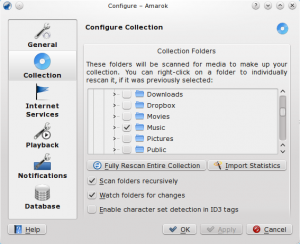
Stromový pohled na váš domovský adresář je ukázán výše. Klepněte na políčko, kde je uložena vaše hudba; obvykle ve složce ~ /Hudba. Potom zvolte . To bude nějaký čas trvat, takže se neznepokojujte, pokud se zdá být Amarok chvíli pomalejší. Jakmile je prohledávání dokončeno, je nejlepší Amarok ukončit přes hlavní nabídku , nebo Ctrl+Q , a znovu jej opět spustit. Vaše nově přidaná hudba by se měla ukázat v části s Místní sbírkou.
Přidání zařízení s hudbou do sbírky
Pod vyhledávacím polem v horní části pole s hudebními zdroji vidíte různá zařízení a/nebo obsahové skupiny v rámci Prohlížeče obsahu. Pokud vložíte CD s hudbou do jednotky CD-ROM, objeví se v poli s hudebními zdroji, společně s přehrávači hudebních souborů, flash disky a jinými zařízeními USB. Poté, co bylo připojeno vnější zařízení, mělo by se automaticky ukázat v poli s hudebními zdroji. Nemusíte projít všemi dalšími činnostmi, abyste vnější zařízení uviděl ve vašem poli s hudebními zdroji, pokud byla rozpoznána vaším počítačem.
Níže je snímek, který ukazuje tři připojené zdroje s hudbou: Audio CD, přehrávač souborů MP3, a Místní sbírku.
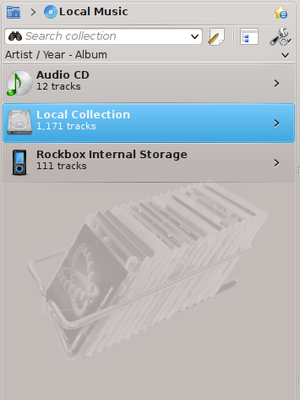
Ripping a CD into the collection
If you don't have any music files on your computer, it's easy to rip them (copy the tracks from your CDs to your collection). Just pop in a CD, and right-click on the banner of the CD device in the Content Browser to play, or copy to your collection, which will rip and tag your tracks (see image below). If you copy music from an audio CD to your Local Collection, the message bar at the bottom of the Amarok window will indicate that it is busy copying. The ripping may take several minutes. Once the rip is complete, the message in the message bar disappears and the music appears in the content browser of your Local Collection. If the ripped music does not appear in your Media Sources pane it's best to quit Amarok from the top-level menu, or Ctrl+Q, and then restart it. Now you should see your collection in the left pane. The screenshot below shows how you move tracks from your audio CD, iPod or other device to your collection, using the right-click menu.
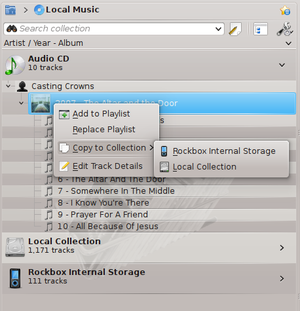
In the above context menu, you can also see the the choice to . Use this option if you have a track that needs a tag edited. This becomes important when you rip music to .WAV format, losing some of the tags. If quite a bit of your collection needs tagging, consider dedicated tagging software, such as
Correct tagging is important to help Amarok show your tracks in the appropriate albums and proper sort order. Learn more about ripping and tagging.
Accessing other media sources
You might have wondered why the Media Sources pane is not called the 'Collections pane'. Amarok gives you access to much more music than just your collection -- Internet shops, audio books, podcasts, music files stored outside your collection, and previously stored playlists. The Amarok breadcrumb navigation is the key to all of this. The starting icon for the breadcrumb navigation is the home folder icon at the extreme top left of the Media Sources pane. This icon expands and contracts as you browse through the Media Sources pane, allowing you to easily navigate your collection by clicking your desired folder in the breadcrumb bar.

If you click the Amarok home folder you see the Media Sources pane on the left below, containing icons to available resources. If you click the Files icon (left image below, second item from the bottom), you will see something similar to the image on the right, below. Notice how the breadcrumb bar expands and how the content of the selected folder is shown in the Media Sources pane (right image below). Clicking the > symbols among the breadcrumbs allows you to view the folders available at that level of the folder structure. The Amarok file browser gives you access to your entire file system, even outside your Local Collection.
| Media Sources pane | Files icon clicked |
|---|---|
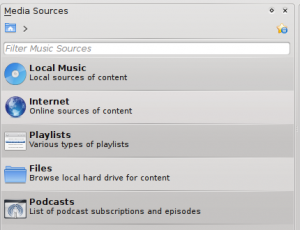 |
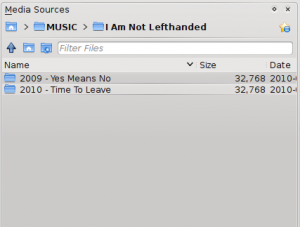 |
The functions of the icons in the Amarok Home folder (left above) are:
| Icon | Name | Action |
|---|---|---|
| Local Music | Your Amarok collection | |
| Internet | Internet shops such as Magnatune, Jamendo and Last.fm. First configure your internet resources in: | |
| Playlists | Saved playlists -- see also Playlists. Also playlists on media devices | |
| Files | Your file system | |
| Podcasts | Access to Podcasts via RSS feed |
Clicking the Local Music icon above or on the Local Music folder in the breadcrumb bar returns you to your collection, showing you a list of all the available resources, artists, albums and tracks that you have previously defined as part of your collection. The breadcrumb bar indicates that you are viewing your Local Music.
Streams and Podcasts
There are two ways to listen to streams. If you have a favorite station, get the stream URL and add it: . You'll be able to find it again in Playlists, as a Saved Playlist. Otherwise, browse through the scripts available in our Script Manager (). There are some excellent collections available, which will show up in the Internet section of your Media pane.
Podcasts have their own section in the Media Pane, above. If you have an RSS or Atom feed URL, click the green and add it there. If you have an OPML file to import, that choice is available also. Use the context (right-click) menus to , , , , or mark an episode as New. If you are interested in browsing through a large collection of podcasts, check out the Podcast Directory available through the Script Manager, referred to above.
Using the Content Browser
The hard disk of your computer, audio CDs, external devices and the Internet are the basic resources for your collection. After your collection has been set up, it is likely that your collection will hold a large number of albums and tracks, much more than can be shown on a single window.
How to change the display of your collection, below:
Hiding or expanding information
The area of the Media Sources pane below the search bar is called the Content Browser. Three media sources are indicated in the image of a Content Browser below: CD, Local Collection and a Media Player:
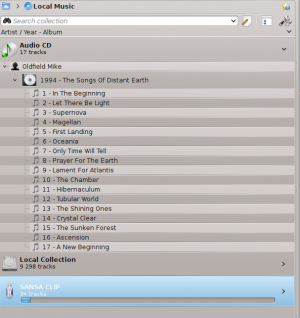
Clicking the banner for a device (the blue bar for the Sansa above) shows or hides the content of that device. The direction of the arrow on the right indicates whether the contents for that device is hidden or shown. The content on a particular device can, in turn, be hidden or shown using the same principle, clicking on the appropriate artist or album. An arrow pointing down on the left of an artist or an album indicates that the contents has been expanded. An arrow pointing right indicates that more content for that category is available but currently hidden. In the image above, the information for Mike Oldfield - The Songs of Distant Earth CD has been expanded, showing the individual tracks. On the other hand, the albums and tracks in the Local Collection are hidden. By clicking these arrows you also can expand or hide information.
Changing the order of tracks and albums
The order in which tracks are sorted in the Content Browser can be customised by using the Sort Options button at the top of the Media Sources pane:

The sort order is indicated on the top left of the Media Sources pane, just below the Search text box. The default order is Artist / Year - Album. The display order of the Content Browser can be temporarily switched between the user-defined sort order (described above) and a Merged view in which which artists are listed alphabetically, no matter on which media the music is stored. To toggle the Merged view, click the Merge icon at the top right-hand of the Media Sources pane:

To search your collection, type your search term into the search bar at the top of the Local Music section. Not only can you search by artist, album or track name, but any part. You might create a nice playlist by searching for winter, for instance, or merely find a track when you only remember one word of the title. You can also search by rating, playcount, even filetype. See Amarok Insider Issue 14 for more details.
Deleting items from the collection
You can delete any item from your collection by right-clicking on it and choosing the bottom item . A confirmation dialog will appear, preventing the accidental deletion of any tracks. More than one item can be selected with Ctrl+click.

